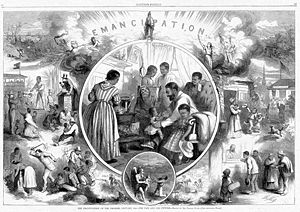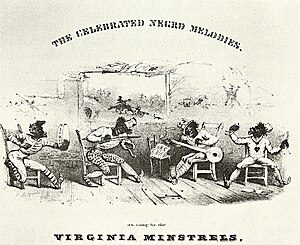Origins of the blues
Little is known about the exact origin of the music now known as the
Precursive African Elements of Black American Blues
There are few characteristics common to all blues, as the genre takes its shape from the distinctive attributes of each individual performance.
Many of these blues elements, such as the call-and-response format, can be traced back to the
Perhaps the most compelling African instrument that is a predecessor to an African-American instrument is the "
While the findings of Kubik and others clearly attest to the essential Africanness of many essential aspects of blues expression, studies by
Other African influence
The historian
There was a difference in the music performed by the predominantly Muslim
Influence of field hollers
Influence of spirituals
The most important American antecedent of the blues was the
Social and economic aspects


The social and economic reasons for the appearance of the blues are not fully known.
Several scholars characterize the early 1900s development of blues music as a move from group performances to a more individualized style. They argue that the development of the blues is associated with the newly acquired freedom of the slaves. According to Lawrence Levine,[17] "there was a direct relationship between the national ideological emphasis upon the individual, the popularity of Booker T. Washington's teachings, and the rise of the blues." Levine states that "psychologically, socially, and economically, Negroes were being acculturated in a way that would have been impossible during slavery, and it is hardly surprising that their secular music reflected this as much as their religious music did."
An important reason for the lack of certain knowledge about the origins of the blues is the earliest blues musicians' tendency to wander through communities, leaving little or no record of precisely what sort of music they played or where it came from. Blues was generally regarded as lower-class music, unfit for documentation, study or enjoyment by the upper- and middle-classes[18]
Blues around 1900

Blue notes pre-date their use in blues. English composer Samuel Coleridge-Taylor's "A Negro Love Song", from his The African Suite for Piano composed in 1898, contains blue third and seventh notes.[19]
African American composer W. C. Handy wrote in his autobiography of the experience of sleeping on a train traveling through (or stopping at the station of) Tutwiler, Mississippi around 1903, and being awakened by:
... a lean, loose-jointed Negro who had commenced plucking a guitar beside me while I slept. His clothes were rags; his feet peeped out of his shoes. His face had on it some of the sadness of the ages. As he played, he pressed a knife on the strings in a manner popularized by Hawaiian guitarists who used steel bars. ... The effect was unforgettable. His song, too, struck me instantly... The singer repeated the line ("Going' where the Southern cross' the Dog") three times, accompanying himself on the guitar with the weirdest music I had ever heard.
Handy had mixed feelings about this music, which he regarded as rather primitive and monotonous,
Blues later adopted elements from the "Ethiopian (here, meaning "
Since the 1890s, the American sheet music publishing industry had produced a great deal of ragtime music. The first published ragtime song to include a 12-bar section was "One o' Them Things!" in 1904. Written by James Chapman and Leroy Smith, it was published in St. Louis, Missouri, by Jos. Plachet and Son.[24] Another early rag/blues mix was "I Got the Blues" published in 1908 by Antonio Maggio of New Orleans [25]
In a long interview conducted by
Continued development of the blues in the 1910s
In 1912, the sheet music industry published another blues composition—"
Handy was a formally trained musician, composer and arranger who helped to popularize the blues by transcribing and orchestrating blues in an almost symphonic style, with bands and singers. He became a popular and prolific composer, and billed himself as the "Father of the Blues"; however, his compositions can be described as a fusion of blues with ragtime and jazz, a merger facilitated using the
Songs from this period had many different structures. A testimony of those times can be found for instance in
Growth of the blues (1920s onward)
One of the first professional blues singers was Gertrude "Ma" Rainey, who claimed to have coined the term blues. Classic female urban or vaudeville blues singers were popular in the 1920s, among them Mamie Smith, Ma Rainey, Bessie Smith, and Victoria Spivey. Mamie Smith, more a vaudeville performer than a blues artist,[36] was the first African-American to record a blues in 1920; her "Crazy Blues" sold over 75,000 copies in its first month.[37]
The musical forms and styles that are now considered the "blues" as well as modern "
Notes
- ^ a b Southern, p. 332
- ^ Baraka 1999 pg 17
- ISBN 1-57806-146-6
- ^ a b Southern, p. 334
- ^ a b c Southern, p. 333
- ^ Garofalo, p. 44
- ^ Ferris, p. 229
- ^ "Our Homage to a Great Master - Ali Farka Toure | Global South, Sephis e-Magazine". Archived from the original on 2014-10-17. Retrieved 2010-08-14.
- ^ Paul Kelbie, "Gospel Truth - Hebrides Invented Church Spirituals", The Independent - UK, 9-19-3
- ^ "MUSIC: Exploring Native American influence on the blues". Americanindiannews.org.
- ^ a b c d e Curiel, Jonathan (August 15, 2004). "Muslim Roots of the Blues". SFGate. San Francisco Chronicle. Archived from the original on September 5, 2005. Retrieved August 24, 2005.
- ^ ISBN 9781317744023.
- ^ ISBN 0-02-061740-2.
- ^ Southern, p. 333-334
- ISBN 0-521-45429-8, p. 285
- ^ "Volume 2 : African American Music : Chapter 10. McIntosh County Shouters: Slave Shout Songs from the Coast of Georgia". Stg.brown.edu. Retrieved 12 February 2019.
- ISBN 0-19-502374-9, p. 223
- ^ Southern, p. 332-333
- ^ Scott, Derek B. From the Erotic to the Demonic: On Critical Musicology. Oxford University Press, (2003) p. 182: "A blues idiom is hinted at in "A Negro Love-Song", a pentatonic melody with blue third and seventh in Coleridge-Taylor's African Suite of 1898, many years before the first blues publications."
- ^ Parrish, Tim; Walking Blues: Making Americans from Emerson to Elvis, University of Massachusetts Press (2001), p. 185: "Handy declares their music to be an endless 'monotony,' a 'thump-thump-thump' sound that he associates—with evident distaste—with 'cane rows and levee camps' (77). Nor does he admire the enthusiastic dancing the music elicits."
- ^ Wald, Elijah; Escaping the Delta: Robert Johnson and the Invention of the Blues, Harper Collins (2004), p. 283: "When the popular taste for blues asserted itself I took out that old number and changed its name to 'Yellow Dog Blues.' Other than the name, I altered nothing."
- ^ Garofalo, p. 44 Gradually, instrumental and harmonic accompaniment were added, reflecting increasing cross-cultural contact. Garofalo goes on to cite others mentioning the "Ethiopian airs" and "Negro spirituals".
- ^ Schuller, cited in Garofalo, p. 27
- ^ Saffle, Michael, Perspectives on American Music, 1900-1950, Routledge (2000) p. 74: "Chapman and smith's "One O' Those Things" (1904) an earlier blues/rag mix (see Figure 3.2)."
- ^ Saffle, Michael, Perspectives on American Music, 1900-1950, Routledge (2000) p. 74: "In Maggio's "I Got the Blues" (1908), a twelve-bar blues in G Major is followed by a section in G minor, ending with a rag riff (see Figure 3.1).
- ISBN 978-0465018123.
- ISBN 0-306-80014-4, pages 34-35: "The first was Hart Wand's "Dallas Blues", published in March; the second was Arthur Seals's "Bab Seals' Blues", published in August; Handy finally brought out his blues in September. Both Handy and Arthur Seals were Negroes, but the music that they titled "blues is more or less derived from the standard popular musical styles of the "coon-song" and "cake-walk" type. It is ironic the first published piece in the Negro "blues idiom", Dallas Blues, was by a white man, Hart Wand."
- ^ Saffle, Michael, Perspectives on American Music, 1900-1950, Routledge (2000), p. 74: "White's "Original Chicago Blues" (1915) is a later blues/rag almagam, as is "The Memphis Blues."
- ^ Garofalo, p. 27; Garofalo cites Barlow in Handy's sudden success demonstrated [the] commercial potential of [the blues], which in turn made the genre attractive to the Tin Pan Alley hacks, who wasted little time in turning out a deluge of imitations. (parentheticals in Garofalo)
- ^ Monge, Luigi; David Evans. "New Songs of Blind Lemon Jefferson". Journal of Texas Music History 3:2 (Fall 2003), p. 19: "In fact, in addition to its textual relationship in the first stanza to 'Michigan Water Blues,' Jefferson's 'Light House Blues' is related textually and musically to an even older song, 'The Negro Blues'/'Nigger Blues' by Leroy 'Lasses' White of Dallas. White registered his tune with a set of fifteen three-line stanzas for copyright on November 9, 1912, under the former title. In 1913, a shortened version of the piece was published under the latter infelicitous title, containing only six stanzas, five of which are close variants of stanzas in the longer version and one of which is new."
- ^ Garofalo, p. 27
- ^ Morales, p. 277
- ^ Palmer, p. 35
- ^ Garofalo, pp. 46-47
- ^ Ewen, p. 143
- ^ Palmer, p. 106
- ^ Hawkeye Herman, General background on African American Music, Blues Foundation, Essays: What is the blues?"Blues Foundation :: Essays". Archived from the original on December 10, 2008. Retrieved October 15, 2010.
- ^ Garofalo, pp. 44-47 As marketing categories, designations like race and hillbilly intentionally separated artists along racial lines and conveyed the impression that their music came from mutually exclusive sources. Nothing could have been further from the truth... In cultural terms, blues and country were more equal than they were separate. Garofalo claims that artists were sometimes listed in the wrong racial category in record company catalogues.
References
- Curiel, Jonathan (August 15, 2004). "Muslim Roots of the Blues". SFGate. Archived from the original on September 5, 2005. Retrieved August 24, 2005.
- Ewen, David (1957). Panorama of American Popular Music. ISBN 0-13-648360-7.
- Ferris, Jean (1993). America's Musical Landscape. Brown & Benchmark. ISBN 0-697-12516-5.
- Garofalo, Reebee (1997). Rockin' Out: Popular Music in the USA. ISBN 0-205-13703-2.
- Hamilton, Marybeth (2007). In Search of the Blues. ISBN 9780224060189.
- ISBN 0-289-79828-0.
- ISBN 978-0-14-006223-6.
- Schuller, Gunther (1968). Early Jazz: Its Roots and Musical Development. ISBN 0-19-504043-0.
- Southern, Eileen (1997). The Music of Black Americans. ISBN 0-393-03843-2.
